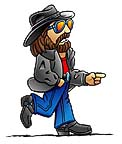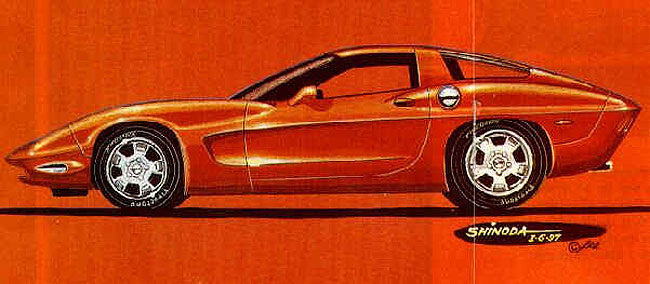Dateline: 3.30.12
Hot rodder Shinoda teams up with Bill Mitchell and defined the “Corvette look.”
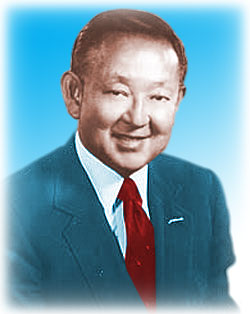 Perhaps it was “in the stars” that Larry Shinoda was in the right place at the right time. If you strictly look at Shinoda’s resume in 1956, you might ask, “How did this guy get in the front door?” As a young man, the only thing Larry ever graduated from was high school, Army boot camp, and the School of Hard Knocks. Twelve-year-old Larry had his life turned inside out when along with thousands of Japanese-Americans, he and his family were sent to interment camps for the duration of WW II. The experience had a profound effect on his personality. A self-professed “malcontent” Shinoda could be a little difficult to work with.
Perhaps it was “in the stars” that Larry Shinoda was in the right place at the right time. If you strictly look at Shinoda’s resume in 1956, you might ask, “How did this guy get in the front door?” As a young man, the only thing Larry ever graduated from was high school, Army boot camp, and the School of Hard Knocks. Twelve-year-old Larry had his life turned inside out when along with thousands of Japanese-Americans, he and his family were sent to interment camps for the duration of WW II. The experience had a profound effect on his personality. A self-professed “malcontent” Shinoda could be a little difficult to work with.
After his Army tour of duty in Korea, Shinoda attended Art Center School of Design in Los Angeles, but truly hated being there. He could see no purpose in taking the classes in design and the various art mediums, such as watercolor painting. He was a car guy/hot rodder and he wanted to draw and design cars! So he left Art Center without graduating and based strictly on his car illustrations, landed a job at Ford, then Studebaker/Packard. Just a year after starting his career, he landed a job as a designer at General Motors.
The rest is the stuff of legend. Street racing and blowing the doors off of Bill Mitchell’s souped up Buick and quickly being taken under Mitchell’s wing. Things like that happens, but rarely. There was obviously some chemistry between the two men, perhaps it was because both men could be brash and had strong opinions.
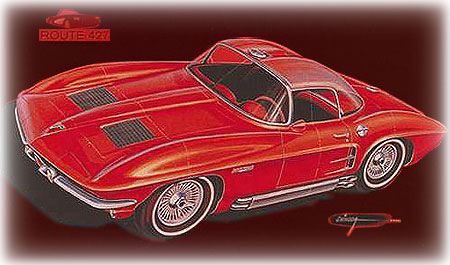 Shinoda got his first big break when Mitchell tapped the 28-year-old to translate the body design of the ‘57 Q-Corvette on to the mule chassis from Duntov’s aborted Corvette SS project. The finished car became Mitchell’s 1959 Stingray Racer, which formed the styling theme for the ‘63 Corvette. From there, Shinoda got one peach project after another. It’s worth noting that the design of the Stingray Racer is held in such high esteem that current Corvette chief designer, Tom Peters (C6 Corvette and late model Camaro designer) is on record stating that his ‘09 Corvette Stingray Concept (aka Transformers Corvette) was influenced by the ‘59 Stingray.
Shinoda got his first big break when Mitchell tapped the 28-year-old to translate the body design of the ‘57 Q-Corvette on to the mule chassis from Duntov’s aborted Corvette SS project. The finished car became Mitchell’s 1959 Stingray Racer, which formed the styling theme for the ‘63 Corvette. From there, Shinoda got one peach project after another. It’s worth noting that the design of the Stingray Racer is held in such high esteem that current Corvette chief designer, Tom Peters (C6 Corvette and late model Camaro designer) is on record stating that his ‘09 Corvette Stingray Concept (aka Transformers Corvette) was influenced by the ‘59 Stingray.
During his almost 13 years at GM, Larry designed numerous special Corvettes, Corvairs, and several race cars, as well as his usual duties working out the styling details of various production cars. Presented here are Larry Shinoda’s most important Corvette designs. Later this week, we’ll take a look at Larry’s very slick Corvairs, and race cars, including the body design for Pat Flaherty’s 1956 Indy 500-winning Watson-Offenhauser.– Scott
Related: Larry Shinoda Interview By Tom Benford From December 1997 Vette Magazine, HERE.
Corvette Timeline Tales: Happy 82nd Birthday Larry Shinoda, HERE.
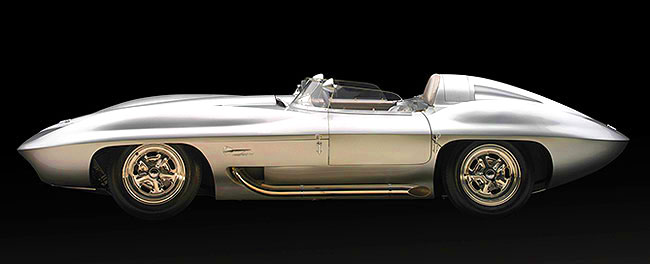 1959 Stingray Racer
1959 Stingray Racer
The 1959 Stingray Racer is still a stunningly beautiful car design. The idea of a “broad, flat top surface” was to create a reverse airfoil that would pull the car down. The problem was that the sharp leading edge was too high and at high speed, more air was knifing under the car rather than going over the car, causing a serious front lift problem. The production Sting Rays and even the Grand Sport Corvettes all had the same trouble. This could have been corrected with a slight forward rake, if the nose had drooped down a n inch or so, and a chin spoiled was added. The Grand Sport replica cars from Duntov Motors use these corrections and front end stays where it belongs at high speed – DOWN.
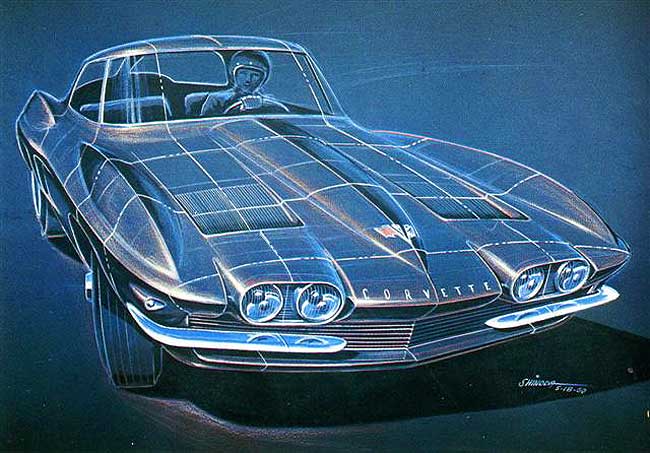 1963 Sting Ray Concept Art
1963 Sting Ray Concept Art
The road to fully worked out new car designs was littered with concept art – most of which was probably thrown away. Here we see a headlight treatment study. Sorting out the production car’s rotating hidden-headlight design was a brilliant but challenging project. Note the absence of hood lines and windshield wipers. It also looks like they were considering scoops on the back edge of the doors.
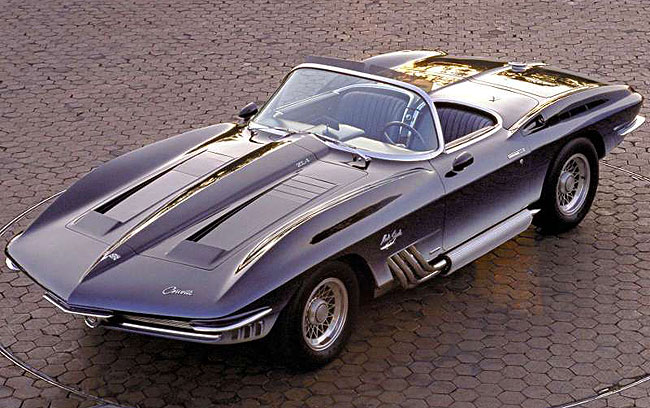 1961 Mako Shark I Showcar – AKA “The Corvette Shark”
1961 Mako Shark I Showcar – AKA “The Corvette Shark”
With the basic Sting Ray design approved for production, Bill Mitchell had Shinoda design an exaggerated version for a teaser show car. Known today as the Mako Shark-I, the car’s original name was simply, “Corvette Shark.” 1961 was still the “Jet Age,” so the car was originally shown with a plexi bubble top. It was kind of “Jetsons” neat-looking, but would anyone really want one for their daily driver?
 1963 4-Seater Sting Ray Split-Window Coupe
1963 4-Seater Sting Ray Split-Window Coupe
The XP-720 4-Seater Corvette Sting Ray was an exploration into the possibility of the Corvette competing with the much better-selling Ford Thunderbird. Ed Cole, head of the GM car and truck group, thought it was a pretty good idea. After all, GM is in the business of selling cars – LOTS of cars. Since the public bought 73,051 Thunderbirds in 1961, compared to 10, 939 Corvettes, it seemed like a no-brainer. The story goes that a tall executive got stuck in the back seat and needed quite a bit of help getting out. The 4-seater concept was quickly dropped. Good!
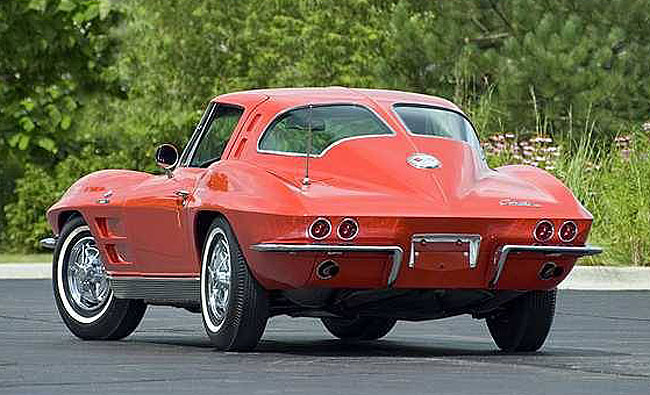 1963 Production Corvette Sting Ray Split-Window Coupe
1963 Production Corvette Sting Ray Split-Window Coupe
Look at 1963 cars from America and Europe and there’s NOTHING like the Corvete Sting Ray. The split-window was one of Bill Mitchell’s pet design elements and was a one year deal. Although the design concept of a “split rear window” wasn’t new with the Sting Ray (the 1950 VW Beetle had a “split” rear window), the overall presentation of the Split-Window Coupe Sting Ray looked like NOTHING else.
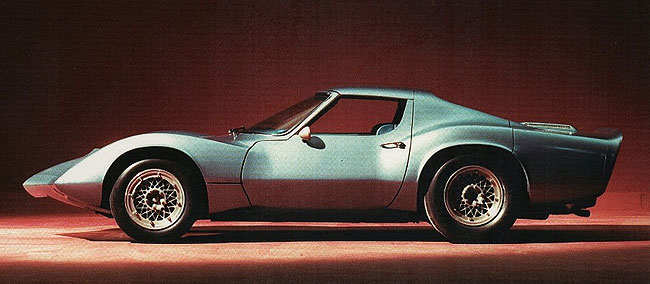 1964 XP-819 Rear-Engine Corvette Engineering Study
1964 XP-819 Rear-Engine Corvette Engineering Study
The Corvair was the only production car to come out of Ed Cole’s ‘57 Q-Chevrolet initiative and was considered very exotic when it came out in 1960. But trouble quickly set in and it wasn’t just Ralph Nader’s doing. The early Corvairs were not good cars. But the “rear-engine” concept was very alluring to Chevy engineer Frank Winchell. Frank insisted that with the correct size tires the inherent oversteering problem could be corrected. Winchell envisioned a rear-engine Corvette and Zora Duntov said, “No!” To prove his point, Winchell had Shinoda design a pretty body to cover the big V8 engine hanging out behind the trans-axle. Upon seeing Shinoda’s rough full-size drawing, Duntov asked, “Where did you cheat?” Where he cheated was that there were no real rear bumpers or crash zone on the back end. The concept was quickly dropped. it was also discovered that the car did excellent wheelies!
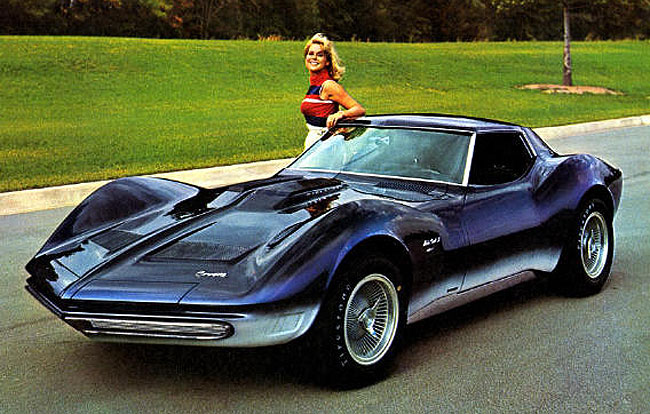 1966 Running Mako Shark-II Showcar
1966 Running Mako Shark-II Showcar
Bill Mitchell verbalized the parameters of the design and Larry Shinoda and a small group of designers and stylists worked out the details. It was as if lightning had struck twice – first with the Sting Ray and a few years later with the Mako Shark-II. The exaggerated fender humps have become THE signature Corvette profile. A non-running full-size version was shown to GM’s management in ‘65 and received unanimous approval as the next Corvette. While the new body and interior designs were being worked out, a second “running” Mako Shark-II was built to keep the Corvette fans stoked. Almost 50 years later, the Mako Shark-II is still a jaw-dropper!
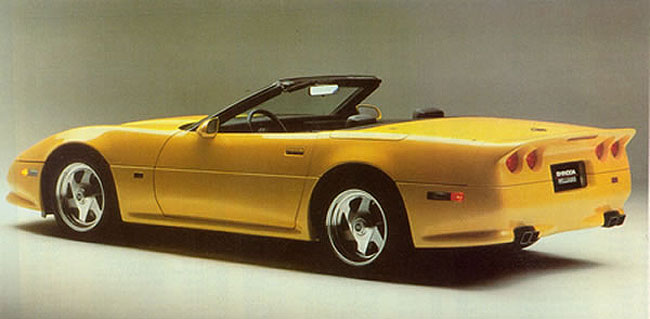 1991 Mears-Shinoda C4 Corvette Body Kit
1991 Mears-Shinoda C4 Corvette Body Kit
Larry left GM in 1968, stayed at Ford for one year, then formed his own design studio where he worked on all kinds of automotive and non-automotive design projects. Corvette body kits and add-on parts became very popular though the ‘70s and ‘80s. Three-time Indy 500 winner, Rick Mears teamed up with Shinoda and businessman Jim Williams in 1991 to create and offer the Rick Mears Special Edition Corvette.
Arguably the cleanest full-body-kit ever offered for a C4 Corvete, the coupe version lowered the coefficient of drag on the car from .34 to .30. The complete kit cost approximately $5,200, plus $3,000 for installation, and around $1,000 for a new paint job. With a cost of just over 10 grand on top of a $32,455 new ‘91 Corvette, there weren’t many takers. But, it was a very nice design.
The all-new C5 1997 Corvette was released in the Fall of ‘96 and Larry Shinoda got right on it. Note the date on the rendering, “1-6-97.” Obviously, Larry wanted to see more “Sting Ray” in the new C5. If you’re a mid-year Corvette fan, Shinoda’s concept looks pretty good. Larry died the following November and to the best of my knowing, there was never an effort to make a full-body kit based on what may well have been Larry’s last Corvette design project. Any fiberglass fabricators out there that would like to take a shot at the Shinoda C5 Sting Ray???
Here’s the BEST way to keep up with K. Scott Teeters’ Corvette blog!


